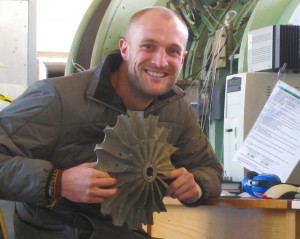
Sam Perkins
In 1930 Sir Frank Whittle patented the design for a gas turbine engine intended for jet propulsion and seven years later, the first engine of its type ran successfully.
Since that time the gas turbine has been extensively developed and is currently used in a wide range of applications including power generation, jet propulsion and the production of rotational mechanical power on land, at sea and in the air.
The most common place gas turbines are found is on the wings of aeroplanes. More than 100,000 planes, carrying millions of passengers and tonnes of cargo to all four corners of the world, take off every day and almost all of these are power by jet engines.
Technology and problem solving on a practical level has always fascinated me and as a child I would spend a lot of my free time taking apart and re-building bikes and tinkering about in the shed. Science and craft were my two main areas of interest at school and they created a nice balance of practical and theoretical problem solving with real world applications. After college, the natural progression for me was to enrol in a Bachelor of Engineering, which I started in 2004 at the University of Tasmania. I studied Mechanical Engineering and quickly developed an interested in aerodynamics, thermodynamics and how much they influence our lives every day.
After graduating in 2007 I spent 6 months travelling through South East Asia and Europe before starting my PhD working with the University of Cambridge and Rolls Royce to improve air flow through jet engines. I was lucky to spend a year and a half at the University of Cambridge to carry out the experimental portion of my PhD before returning the UTAS where I completed my thesis at the beginning of 2012.
Currently I am working as a lecturer at the School of Engineering and am part of a research project investigating ways to improve the efficiency of hydro power schemes in Tasmania.
Engineering has opened my eyes to how the world around us works and how much potential there is to use technology to conquer the greatest challenges imaginable. It has also opened doors and career options in areas I never dreamed of working in from humanitarian aid work to investment banking.
In the future I plan to use skills to work in a humanitarian focussed field with the aim of improving the lives of those currently struggling in the world around us with a particular emphasis on education and the sharing of tangible technical skills.
For more information: www.utas.edu.au/engineering/home; www.engineersaustralia.org.au; www.engineeryourcareer.org.au
